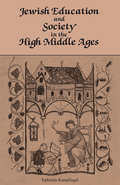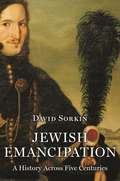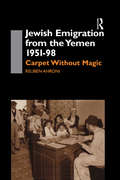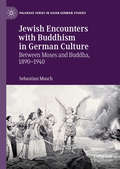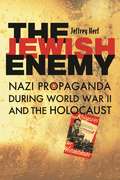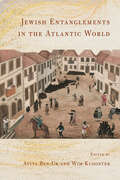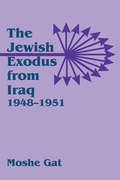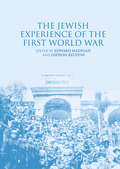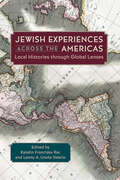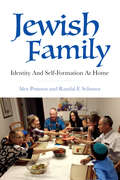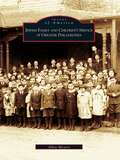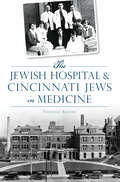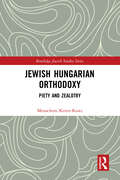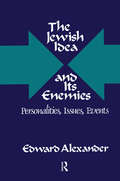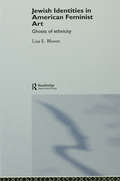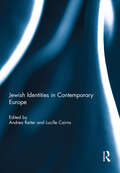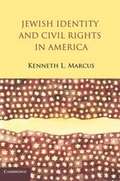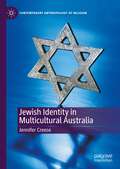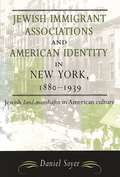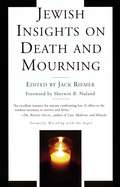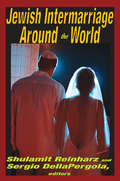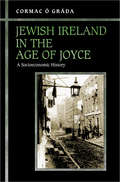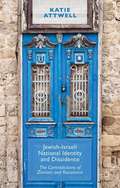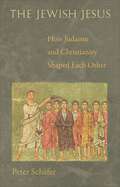- Table View
- List View
Jewish Education and Society in the High Middle Ages
by Ephraim KanarfogelPaperback edition of a favorite text on the literary creativity and communal involvement in the production of the Tosafist corpus.
Jewish Emancipation: A History Across Five Centuries
by David SorkinThe first comprehensive history of how Jews became citizens in the modern worldFor all their unquestionable importance, the Holocaust and the founding of the State of Israel now loom so large in modern Jewish history that we have mostly lost sight of the fact that they are only part of—and indeed reactions to—the central event of that history: emancipation. In this book, David Sorkin seeks to reorient Jewish history by offering the first comprehensive account in any language of the process by which Jews became citizens with civil and political rights in the modern world. Ranging from the mid-sixteenth century to the beginning of the twenty-first, Jewish Emancipation tells the ongoing story of how Jews have gained, kept, lost, and recovered rights in Europe, North Africa, the Middle East, the United States, and Israel.Emancipation, Sorkin shows, was not a one-time or linear event that began with the Enlightenment or French Revolution and culminated with Jews' acquisition of rights in Central Europe in 1867–71 or Russia in 1917. Rather, emancipation was and is a complex, multidirectional, and ambiguous process characterized by deflections and reversals, defeats and successes, triumphs and tragedies. For example, American Jews mobilized twice for emancipation: in the nineteenth century for political rights, and in the twentieth for lost civil rights. Similarly, Israel itself has struggled from the start to institute equality among its heterogeneous citizens.By telling the story of this foundational but neglected event, Jewish Emancipation reveals the lost contours of Jewish history over the past half millennium.
Jewish Emigration from the Yemen 1951-98: Carpet Without Magic
by Reuben AhroniThe Yemeni Jewish remnants have triggered so much interest on the part of so many western governments and humanitarian organizations, to an extent that is quite rare.The story of the Yemeni Jewish remnants is distinct from that of their brethren who emigrated to Israel during Operation Magic Carpet (1949-51). Before and during Operation Magic Carpet, Yemeni Jews came on their own in overwhelming numbers, many of them on foot, undeterred by the prospects of the trials and tribulations which they knew would await them in the course of their travels. In contrast, the Yemeni Jewish remnants displayed a strong hesitation, if not reluctance, to leave Yemen. Thus, since Operation Magic Carpet and until 1962 - the year of the coup d'état eliminating the autocratic Imamic regime in Yemen and the closing of the Yemeni gates for Jewish emigration - only some four hundred Yemeni Jews heeded the call to emigrate to Israel. It is for this reason that the book is subtitled Carpet Without Magic. A 'red carpet' was indeed spread before the Yemeni Jewish remnants, but the 'magic' was no longer there.
Jewish Encounters with Buddhism in German Culture: Between Moses and Buddha, 1890–1940 (Palgrave Series in Asian German Studies)
by Sebastian MuschIn Germany at the turn of the century, Buddhism transformed from an obscure topic, of interest to only a few misfit scholars, into a cultural phenomenon. Many of the foremost authors of the period were profoundly influenced by this rapid rise of Buddhism—among them, some of the best-known names in the German-Jewish canon. Sebastian Musch excavates this neglected dimension of German-Jewish identity, drawing on philosophical treatises, novels, essays, diaries, and letters to trace the history of Jewish-Buddhist encounters up to the start of the Second World War. Franz Rosenzweig, Martin Buber, Leo Baeck, Theodor Lessing, Jakob Wassermann, Walter Hasenclever, and Lion Feuchtwanger are featured alongside other, lesser known figures like Paul Cohen-Portheim and Walter Tausk. As Musch shows, when these thinkers wrote about Buddhism, they were also negotiating their own Jewishness.
The Jewish Enemy: Nazi Propaganda during World War II and the Holocaust
by Jeffrey Herf<p>The sheer magnitude of the Holocaust has commanded our attention for the past sixty years. The extent of atrocities, however, has overshadowed the calculus Nazis used to justify their deeds. <p>According to German wartime media, it was German citizens who were targeted for extinction by a vast international conspiracy. Leading the assault was an insidious, belligerent Jewish clique, so crafty and powerful that it managed to manipulate the actions of Roosevelt, Churchill, and Stalin. Hitler portrayed the Holocaust as a defensive act, a necessary move to destroy the Jews before they destroyed Germany. <p>Joseph Goebbels, Minister of Propaganda, and Otto Dietrich’s Press Office translated this fanatical vision into a coherent cautionary narrative, which the Nazi propaganda machine disseminated into the recesses of everyday life. Calling on impressive archival research, Jeffrey Herf recreates the wall posters that Germans saw while waiting for the streetcar, the radio speeches they heard at home or on the street, the headlines that blared from newsstands. The Jewish Enemy is the first extensive study of how anti-Semitism pervaded and shaped Nazi propaganda during World War II and the Holocaust, and how it pulled together the diverse elements of a delusionary Nazi worldview. Here we find an original and haunting exposition of the ways in which Hitler legitimized war and genocide to his own people, as necessary to destroy an allegedly omnipotent Jewish foe. In an era when both anti-Semitism and conspiracy theories continue to influence world politics, Herf offers a timely reminder of their dangers along with a fresh interpretation of the paranoia underlying the ideology of the Third Reich.</p>
Jewish Entanglements in the Atlantic World
Jewish Entanglements in the Atlantic World represents the first collective attempt to reframe the study of colonial and early American Jewry within the context of Atlantic History. From roughly 1500 to 1830, the Atlantic World was a tightly intertwined swathe of global powers that included Europe, Africa, North and South America, and the Caribbean. How, when, and where do Jews figure in this important chapter of history? This book explores these questions and many others. The essays of this volume foreground the connectivity between Jews and other population groups in the realms of empire, trade, and slavery, taking readers from the shores of Caribbean islands to various outposts of the Dutch, English, Spanish, and Portuguese empires.Jewish Entanglements in the Atlantic World revolutionizes the study of Jews in early American history, forging connections and breaking down artificial academic divisions so as to start writing the history of an Atlantic world influenced strongly by the culture, economy, politics, religion, society, and sexual relations of Jewish people.
The Jewish Exodus from Iraq, 1948-1951
by Moshe GatIn this study, Moshe Gat details how the immigration of the Jews from Iraq in effect marked the eradication of one of the oldest and most deeply-rooted Diaspora communities. He provides a background to these events and argues that both Iraqi discrimination and the actions of the Zionist underground in previous years played a part in the flight. The Denaturalization law of 1950 saw tens of thousands of Jews registering for emigration, and a bomb thrown at a synagogue in 1951 accelerated the exodus.
The Jewish Experience of the First World War
by Edward Madigan Gideon ReuveniThis book explores the variety of social and political phenomena that combined to the make the First World War a key turning point in the Jewish experience of the twentieth century. Just decades after the experience of intense persecution and struggle for recognition that marked the end of the nineteenth century, Jewish men and women across the globe found themselves drawn into a conflict of unprecedented violence and destruction. The frenzied military, social, and cultural mobilisation of European societies between 1914 and 1918, along with the outbreak of revolution in Russia and the collapse of the Ottoman Empire in the Middle East had a profound impact on Jewish communities worldwide. The First World War thus constitutes a seminal but surprisingly under-researched moment in the evolution of modern Jewish history. The essays gathered together in this ground-breaking volume explore the ways in which Jewish communities across Europe and the wider world experienced, interpreted and remembered the ‘war to end all wars’.
Jewish Experiences across the Americas: Local Histories through Global Lenses
by Katalin Franciska Rac Lenny A. Ureña ValerioLatin American Jewish Studies Association Best Edited VolumeThis volume explores the local specificities and global forces that shaped Jewish experiences in the Americas across five centuries. Featuring a range of case studies by scholars from the United States, Brazil, Europe, and Israel, it explores the culturally, religiously, and politically diverse lives of Jewish minorities in the Western Hemisphere.The chapters are organized chronologically and trace four global forces: the western expansion of early modern European empires, Jewish networks across and beyond empires, migration, and Jewish activism and participation in international ideological movements. The volume weaves together into one narrative the histories of communities and individuals separated by time and space, such as the descendants of Portuguese converts, Moroccan immigrants to Brazil, and U.S.-based creators of Yiddish movies.Through its transnational focus and close attention paid to local circumstances, this volume offers new insights into the multicultural pasts of the Americas’ Jewish populations and of the different regions that make up North, Central, and South America.Contributors: Lenny A. Ureña Valerio | Elisa Kriza | Raanan Rein | Adriana M. Brodsky | Lucas de Mattos Moura Fernandes | Katalin Franciska Rac | Zachary M Baker | Neil Weijer | Hilit Surowitz-Israel | Isabel Rosa Gritti | Tamar Herzog | Jose C Moya | Sandra McGee Deutsch | Dana RabinPublication of this work made possible by a Sustaining the Humanities through the American Rescue Plan grant from the National Endowment for the Humanities.
Jewish Family: Identity and Self-Formation at Home (The Modern Jewish Experience)
by Alex Pomson Randal F. SchnoorIn Jewish Family: Identity and Self-Formation at Home Alex Pomson and Randal F. Schnoor advance a new appreciation for the deep significance of Jewish family in developing Jewish identity. This book is the result of ten years of research focused on a small sample of diverse families. Through their work, the authors paint an intricate picture of the ecosystem that the family unit provides for identity formation over the life course. They draw upon theories of family development as well as sociological theories of the transmission of social and cultural capital in their analysis of the research. They find that family networks, which are often intergenerational, are just as significant as cultural capital, such as knowledge and competence in Judaism, to the formation of Jewish identity. Pomson and Schnoor provide readers with a unique view into the complexity of being Jewish in North America today.
Jewish Family and Children's Service of Greater Philadelphia (Images of America)
by Allen MeyersJewish Family and Children's Service of Greater Philadelphia (JFCS) resulted from the merger of two important human service organizations in 1983: the Association for Jewish Children of Philadelphia and Jewish Family Service of Philadelphia. Helping one in four Jewish households in crisis and in need as well as thousands of others, JFCS plays a primary role in the Greater Philadelphia community. The earliest predecessor of JFCS, the Jewish Foster Home, opened in 1855 with five children in its care. Established through the leadership of Rebecca Gratz, the foremost American Jewish female leader of her day, it was the nation's first Jewish orphanage and heralded a record of compassion, skill, and innovation in community services. Today, JFCS reaches out to more than 41,000 individuals and families each year with a wide array of programs from adoption to senior services. Jewish Family and Children's Service of Greater Philadelphia is the first illustrated history of this organization. With numerous historic photographs, including images from the 150th anniversary celebration in 2005, this book touches on all aspects of the organization's history: services, programs, staff, and fund-raising.
Jewish Hospital & Cincinnati Jews in Medicine, The (American Heritage)
by Frederic KromeCincinnati Jewish Hospital has remained a beacon of service to the city for more than a century and a half. Although it always accepted patients regardless of their heritage or faith, the institution maintains its Jewish identity. Founded in 1850, the Hospital weathered depressions and wars while reflecting changes that occurred within the Jewish community and the city. Cincinnati's Jewish health professionals pioneered medical education, new treatments for polio and the introduction of new psychological treatments for children. Author Frederic Krome explores the fascinating history of the Cincinnati Jewish Hospital and the many contributions Cincinnati Jews made to the field of medicine.
Jewish Hungarian Orthodoxy: Piety and Zealotry (Routledge Jewish Studies Series)
by Menachem Keren-KratzBeginning with the informal establishment of Jewish Orthodoxy by a Hungarian rabbi in the early nineteenth century, this book traces the history and legacy of Jewish Hungarian Orthodoxy over the course of the last 200 years. To date, no single book has provided a comprehensive overview of the history of Hungarian Orthodoxy, a singularly zealous, fundamental, and separatist faction within Jewish circles. This book describes and explains the impact of this strand of Jewish Orthodoxy – developed in Hungary in the second half of the nineteenth century – across the Jewish world. The author traces the development of Hungarian Orthodoxy in the “new” Jewish territories created in the wake of Hungary’s dismantlement following its defeat in World War I. The book also focuses on Hungarian Orthodoxy in the two spheres where it continued to develop after the Holocaust, namely Israel and the United States. The book concludes with a review of Hungarian Orthodoxy’s legacy in contemporary communities worldwide, most of which are known for their radical anti-Zionist and anti-modernistic strands. The book will prove vital reading for students and academics interested in religious fundamentalism, Hungarian history, and Jewish studies generally.
The Jewish Idea and Its Enemies: Personalities, Issues, Events
by Hadley Cantril Edward AlexanderThis volume deals with the modern fate of the traditional conception of Jews as a covenanted people chosen to receive the Law, whose ultimate purpose is contributing to the universal salvation of mankind. The author shows how, under the influence of liberalism, rationalism, relativism, and other Enlightenment ideologies, this idea was distorted, denied, inverted, yet never entirely obliterated. In his discussions of modern Jewish thinkers and writers and the ideological and political struggles of Zionism and the state of Israel against enemies from without and from within, Alexander shows that the ancient idea of covenant is still alive today, if only in the assumption that Jewish life can lead somewhere so long as Jews remember that it began somewhere. Ranging from literary criticism and the history of ideas to journalism and politics, the book is unified by a point of view unabashedly espousing the Jewish idea and challenging its enemies.
Jewish Identities in American Feminist Art: Ghosts of Ethnicity
by Lisa E. BloomFeaturing sixty-seven illustrations, and providing an important reckoning and visualization of the previously hidden Jewish 'ghosts' within US art, Jewish Identities in American Feminist Art addresses the veiled role of Jewishness in the understanding of feminist art in the United States. From New York city to Southern California, Lisa E. Bloom situates the art practices of Jewish feminist artists from the 1970s to the present in relation to wider cultural and historical issues. Key themes are examined in depth through the work of contemporary Jewish artists including: Eleanor Antin Judy Chicago Deborah Kass Rhonda Lieberman Martha Rosler and many others. Crucial in any study of art, visual studies, women's studies and cultural studies, this is a new and lively exploration into a vital component of US art.
Jewish Identities in Contemporary Europe
by Andrea Reiter and Lucille CairnsProviding an assessment of Jewish identity, this volume presents critical engagements with a number of Jewish writers and filmmakers from a variety of European countries, including Austria, France, Germany, Poland, and the UK. The novels and films discussed explore the meaning of being Jewish in Europe today, and investigate the extent to which this experience is shaped by factors that lie outside the national context, notably by the relationship to Israel. As the recent attacks on Charlie Hebdo, and the targeting of a Jewish supermarket in Paris, demonstrate, these questions are more pressing than ever, and will challenge Jews, as well as Jewish writers and intellectuals, as they explore the answers.This book was originally published as a special issue of Jewish Culture and History.
Jewish Identities in German Popular Entertainment, 1890-1933
by Marline OtteIn 1968, Hollywood adopted a new ratings system that replaced the 1930 Production Code based on prior censorship. Vaughn (history of communications, U. of Wisconsin--Madison) describes industry and government efforts to regulate and control movie content in the wake of that sea change. He first describes the institution of the new system and the reaction of moviemakers. Ratings and other controversies surrounding sex, profanity, violence, drugs, and religion in the movies are then discussed. A number of chapters explore the evolution of the X rating, its association with pornography, the antipornography crusades of Reagan administration Attorney General Meese and others, and the recent institution of the NC-17 rating. One chapter considers similar issues for television. Annotation ©2006 Book News, Inc. , Portland, OR (booknews. com)
Jewish Identity and Civil Rights in America
by Kenneth L. MarcusGiven jurisdiction over race and national origin but not religion, federal agents have had to determine whether Jewish Americans constitute a race or national origin group. They have been unable to do so. This has led to enforcement paralysis, as well as explosive internal confrontations and recriminations within the federal government. This book examines the legal and policy issues behind the ambiguity involved with civil rights protections for Jewish students. Written by a former senior government official, this book reveals the extent of this problem and presents a workable legal solution.
Jewish Identity in Multicultural Australia (Contemporary Anthropology of Religion)
by Jennifer CreeseThis book offers a timely insight into ideas of ‘belonging’ in multicultural society from a Jewish perspective, one which is largely missing from the discourse on multiculturalism. There is a current climate in Australia, as there is in the United States, Europe and elsewhere, of rising tensions around migration, religious freedom, and far right extremism. These tensions have been fanned the Israeli-Palestine conflict coming under increased international scrutiny in recent months. Understanding how Jewish communities attempt to build and guide an understanding of what Jewishness means in contemporary multicultural societies is crucial for supporting the right to safety in diversity, not only for Jews but for multiple minority groups. In delivering such understanding, this book has insights not only in an Australian, but a broader international, context.This book explores how various facets of Jewish life are experienced and expressed in Australia, drawing on rich ethnographic and archival research conducted within the mid-sized Jewish community in South-East Queensland, Australia, which has never before been examined. Jewish Identity in Multicultural Australia explores how Jewish identity is manifested and experienced across a wide range of facets: religion and religiosity, ethnicity and ethnonational identity, history and memory, antisemitism and racism, Zionism and diasporic identity, and family and kinship. Across these key themes, the book builds on a core argument: that contemporary Jewish communities work in certain, set ways and promote certain, set norms within a framework of state multiculturalism to forge a safe, supported place for Jewish life, practice and identity of all shapes and sizes.
Jewish Immigrant Associations and American Identity in New York, 1880-1939: Jewish Landsmanshaftn in American Culture (American Jewish Civilization Series)
by Daniel SoyerLandsmanshaftn, associations of immigrants from the same hometown, became the most popular form of organization among Eastern European Jewish immigrants to the United States in the late 19th and early 20th centuries. Jewish Immigrant Associations and American Identity in New York, 1880-1939, by Daniel Soyer, holds an in-depth discussion on the importance of these hometown societies that provided members with valuable material benefits and served as arenas for formal and informal social interaction. In addition to discussing both continuity and transformation as features of the immigrant experience, this approach recognizes that ethnic identity is a socially constructed and malleable phenomenon. Soyer explores this process of construction by raising more specific questions about what immigrants themselves have meant by Americanization and how their hometown associations played an important part in the process.
Jewish Insights on Death and Mourning
by Jack RiemerThis collection of Jewish reflections on issues of death and dying make this an indispensable resource for coping with some of life's most difficult moments.
Jewish Intermarriage Around the World
by Sergio DellaPergolaMost research on intermarriage between Jews and non-Jews focuses on the United States. This volume takes a path-breaking approach, examining countries with smaller Jewish populations so as to better understand countries with larger Jewish populations. It focuses on intermarriage in Great Britain, France, Scandinavia, the Soviet Union, Mexico, Venezuela, Canada, South Africa, Australia, Argentina and Curacao, then applies the findings to the United States.In earlier centuries such a volume might have yielded much diff erent conclusions. Then Jews lived in more countries, intermarriage was not as prevalent, and social science had little to contribute. Before World War II, the Jewish population was dispersed much diff erently, and it continues to shift around the world because of both push and pull factors. Like demography, intermarriage is a dynamic process. What is true today was probably not true in the past, nor will it be true tomorrow.The contributors to this volume locate new forms of Jewish family life—single parents, gay/lesbian parents, adults without children, and couples with multiple backgrounds. These multiple family forms raise a new question—what is a Jewish family—as well as a variety of related issues. Do women and men have diff erent roles in intermarriage? Does a family need two people to raise children? Should there be patrilineal descent? Where do adoption, single parenting, lesbian and gay identities, and more, fit into the picture? Broadly, what role does the family play in transmitting a group's culture from generation to generation? This volume presents a portrait of Jewish demography in the twenty-first century, brilliantly interweaving global processes with significant local variations.
Jewish Ireland in the Age of Joyce: A Socioeconomic History
by Cormac Ó GrádaJames Joyce's Leopold Bloom--the atheistic Everyman of Ulysses, son of a Hungarian Jewish father and an Irish Protestant mother--may have turned the world's literary eyes on Dublin, but those who look to him for history should think again. He could hardly have been a product of the city's bona fide Jewish community, where intermarriage with outsiders was rare and piety was pronounced. In Jewish Ireland in the Age of Joyce, a leading economic historian tells the real story of how Jewish Ireland--and Dublin's Little Jerusalem in particular--made ends meet from the 1870s, when the first Lithuanian Jewish immigrants landed in Dublin, to the late 1940s, just before the community began its dramatic decline. In 1866--the year Bloom was born--Dublin's Jewish population hardly existed, and on the eve of World War I it numbered barely three thousand. But this small group of people quickly found an economic niche in an era of depression, and developed a surprisingly vibrant web of institutions. In a richly detailed, elegantly written blend of historical, economic, and demographic analysis, Cormac Ó Gráda examines the challenges this community faced. He asks how its patterns of child rearing, schooling, and cultural and religious behavior influenced its marital, fertility, and infant-mortality rates. He argues that the community's small size shaped its occupational profile and influenced its acculturation; it also compromised its viability in the long run. Jewish Ireland in the Age of Joyce presents a fascinating portrait of a group of people in an unlikely location who, though small in number, comprised Ireland's most resilient immigrant community until the Celtic Tiger's immigration surge of the 1990s.
Jewish-israeli National Identity And Dissidence
by Katie AttwellThis unique book provides a critical perspective on identity in questioning how Israeli Jews manage and manifest their concern for the Palestinian Other, eschewing presenting identities as concrete and, rather, examines their creation through discourse. Zionism and the Israeli state have constructed a Jewish national identity premised on demonisation of the Other. This book explores how internal critics use alternative discourses of identity to re-imagine this Jewish-Israeli national identity, and considers how they might fail. It combines a rigorous theoretical analysis of nationalism with an engaging examination of the identifications and contradictions of eleven Jewish-Israeli individuals. Featuring, among others, high profile journalist Gideon Levy, veteran maverick Uri Davis and literary novelist Dorit Rabinyan, Attwell provides a revealing insight into national identity, political dissent, conflict and resistance.
The Jewish Jesus: How Judaism and Christianity Shaped Each Other
by Peter SchäferHow the rise of Christianity profoundly influenced the development of Judaism in late antiquityIn late antiquity, as Christianity emerged from Judaism, it was not only the new religion that was being influenced by the old. The rise and revolutionary challenge of Christianity also had a profound influence on rabbinic Judaism, which was itself just emerging and, like Christianity, trying to shape its own identity. In The Jewish Jesus, Peter Schäfer reveals the crucial ways in which various Jewish heresies, including Christianity, affected the development of rabbinic Judaism. He even shows that some of the ideas that the rabbis appropriated from Christianity were actually reappropriated Jewish ideas. The result is a demonstration of the deep mutual influence between the sister religions, one that calls into question hard and fast distinctions between orthodoxy and heresy, and even Judaism and Christianity, during the first centuries CE.
